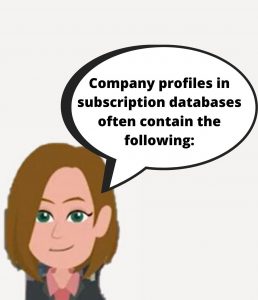(Or what to do if Google overwhelms you.)

Determine if the company is public, private, or subsidiary.
- Use the following databases to determine if the company is public, private, or subsidiary:
- Data Axle (US companies only)
- Hoover’s Academic Pro | tutorial video
- Nexis Uni | tutorial video
- Mergent Online

Select a database for company information:
Public Companies
Consult sources below for information about public companies:
Company History & Directories:
- Data Axle (US companies only)
- International Directory of Company Histories
- Lexis Nexis Corporate Affiliations | tutorial video
- Mergent Online
- ProQuest Historical Annual Reports
Financial Information:
- EDGAR
- Nexis Uni | tutorial video
- Mergent Online
- Capital IQ (GIES only)
Investment Analysis:
Article Databases:
Private Companies
Consult sources below for information about private companies:
- Data Axle (US companies only)
- Hoover’s Academic Pro | tutorial video
- PrivCo | tutorial video
Also, check article databases:
Subsidiary Companies
Consult subsidiary sources below to verify subsidiary status and to get parent company name:
Then use Nexis Uni (tutorial video) to determine if the parent company is public or private.
Follow steps for Public or Private Companies.
Figure out what information you need.

- Revenues (either estimated for private companies or from filings)
- Top Executives & brief bios
- Lines of business
- Revenues (either estimated for private companies or from filings)
- Top Executives & brief bios
- Lines of business
- aka Industries (either NAICS or SICs)
- What it does (makes, services, or both)
- Designates if private or public (subsidiary, branch, parent)
- Competitors (either designated by company or within SIC)
- Option: financials and background/history
- Some may have investment analysis
- Ability to compile lists within an industry, geography, sales range, or stock index